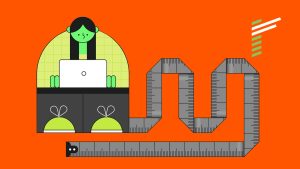Whilst in 2020 many construction companies experienced project delays and high procurement costs due to the supply chain pressure from COVID-19, the construction industry has rebounded strongly by 2022. This is because it is being increasingly supported by government policies to stimulate national economic recoveries. In the United States for example, President Biden tabled a US$2 trillion plan to rebuild and reshape infrastructure.
Despite these plans, smaller construction firms focusing on retail buildings, hospitality, or recreation end markets are likely to experience greater volatility in the coming years. In the long-term efficiency and additional cost savings are crucial for companies to stay competitive.
The depressing truth about the industry is that it is the only industry in the world to register a decline in productivity over the last 50 years. This has been driven by reduced labour hours per day as well as increased quality and safety standards and rising construction complexity.
But the biggest factor, unlike other industries, is simply that it remains heavily dependent on manual labour – take the Burj Khalifa as an example, some 22 million man-hours were required to complete it, with a peak of 12,000 workers on site (interestingly the first residents of the Burj Khalifa were actually the construction labourers – it was cheaper to accommodate them on the lower floors of the building than attempt the logistics of getting them on and off site every day).
Digitalising construction
If you search for locations where construction productivity is high, you quickly arrive at Singapore and Hong Kong, where local laws mandate construction productivity practices, including the extensive use of digital technologies.
In the spring of 2020, a UK Cloud-based solution company found that 75% of engineering and construction companies they surveyed plan to increase spending on digital transformation. Compared to the other sectors, the levels of digitisation in construction is low, the ecosystem is fragmented, and the fault rates are high.
What COVID-19 has brought to the fore is a change in attitude towards digital tools and has expedited decisions on investments in new technologies. Modernisation and digital transformation, therefore, are likely to continue accelerating and will increasingly become the new norms for the industry.
Some of the areas that digital technologies are applied in construction industry include:
Procurement
Electronic ticketing and contactless proof of delivery have been adopted to minimise contacts. Material suppliers and producers share data on tickets with customers through apps, and buyers collect the same information digitally. This allows automatic inter-enterprise operations and real-time visibility of heavy material orders and deliveries.
Operation
Building Information Modelling (BIM), a virtual simulation of an entire construction to optimise build sequences and spot engineering issues, is a hugely important factor in driving productivity. Despite what you may think, most buildings are not engineered, or BIM tested at the start of a project – except for Singapore and Hong Kong, where any property above 4,000 square meters must be BIM tested by law before any tendering is allowed.
Integration of BIM, machine learning, 3D printing and robotics in workflows will be future trends in the construction industry. Usage of drones that give a helicopter view of work sites, materials, equipment, and people is already starting to happen.
Quality surveyors can already incorporate autonomous flying machines to record images and videos to help optimise processes like earned value management and identify differences between actual and as-built site plans.
Worker Safety
Digital technologies can also help reduce risk and improve work safety. For example, wearables. Wearables featuring biometrics help to monitor workers’ heart rates and temperatures, reducing the risk of heat exhaustion and associated health issues when working in extreme conditions.
Site Supervision
Augmented reality is another digital tool that is increasingly common on the jobsite. With intelligent scanning, not only can engineering drawings be virtually overlaid on physical location images, appropriate work instructions, or method statements, that describe best practice techniques and safety protocols, can also be instantly accessed. This will make it easier for foreman, safety officers, and project superintendents to supervise workers and ensure all the regulations and safety rules are followed.
Preventive Maintenance
IoT (5G based) networked sensors will be increasingly used to remotely detect when machinery and equipment need repair, reducing the risk of malfunction.
Automation
AI-powered robotics is gaining traction as a way to automate routine tasks, especially in modular construction. They can weld, pack, dispense and cut materials, all with improved accuracy and less waste. Some experts predict that by the 2050s the industry will see mass layoffs as androids (as in robots not the mobile OS) become common place.
Data Analytics
Huge amounts of data are generated on any jobsite — from CCTVs, sensors, project management and building software, robotics and more. In addition, there are copious amounts of information in communications, bidding and budgeting, materials tracking, equipment purchases and maintenance, progress updates, compliance information and change requests etc.
Digital project management, workflow management and document management platforms for the construction industry have radically improved in the last decade, yet many companies are still struggling with paper trails and manual Excel spreadsheets.
With these improved digital ecosystems, companies can leverage data analytics to pinpoint inefficiencies and improve processes and decision-making. They can easily find and retrieve data needed to satisfy auditing and reporting requirements, eliminating hours of painstaking, manual work. Contractors and sub-contractors can easily access updated blueprints, photos, and videos while also scheduling tasks remotely, restricting how many workers are needed on-site and shortening the time they need to be there.
Conclusion
The digital disruption of the construction industry is underway, the adoption of these new technologies will help to improve safety and productivity whilst reducing costs. However, the effective application of technology does not happen by itself, and there is a major gap in the era of digital transformation in the construction industry – namely a lack necessary skills and experience.
Renoir has been helping clients around the world in their digital transformations to drive sustainable results. Coupled with our expertise on behavioural management, which is especially important in labour intensive environments, we can help organisations build unprecedented value to get ahead of competitors regardless of the market condition. If you’re ready to grow your business, let’s talk.










